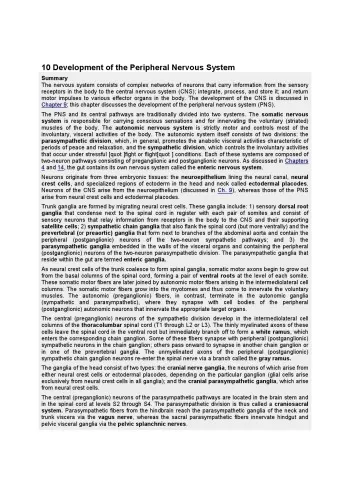Larsen's Human Embryology (chapter10: Development of the Peripheral Nervous System)
4.3
بر اساس نظر کاربران

شما میتونید سوالاتتون در باره کتاب رو از هوش مصنوعیش بعد از ورود بپرسید
هر دانلود یا پرسش از هوش مصنوعی 2 امتیاز لازم دارد، برای بدست آوردن امتیاز رایگان، به صفحه ی راهنمای امتیازات سر بزنید و یک سری کار ارزشمند انجام بدینکتاب های مرتبط:
معرفی کتاب 'Larsen's Human Embryology (Chapter 10: Development of the Peripheral Nervous System)'
کتاب 'Larsen's Human Embryology' یکی از منابع معتبر در زمینه جنینشناسی انسانی است که به تفصیل فرآیندهای رشد و تکامل بدن را از دیدگاه زیستشناسی تکاملی توضیح میدهد. فصل دهم این کتاب به بررسی Development of the Peripheral Nervous System اختصاص دارد.
خلاصه جامع کتاب
در فصل دهم، تمرکز اصلی بر روند شکلگیری سیستم عصبی محیطی (Peripheral Nervous System) در جنین است. این فصل با ساختار پایهای سیستم عصبی آغاز میشود و به بررسی تغییرات سلولی و مولکولی در طی دوران رشد و تکامل میپردازد. موضوعات اصلی شامل مراحلی است که در آن سلولهای عصبی و گلیا از Neural Crest و neural placodes متمایز میشوند. توضیحاتی در خصوص مسیرهای مهاجرت سلولها و اثر نامتقارن رشد نیز ارائه میشود.
نکات کلیدی
- تفاوتهای بین سیستم عصبی مرکزی و محیطی: تحلیل دقیق تفاوتهای ساختاری و عملکردی این دو بخش از سیستم عصبی.
- نقش Neural Crest: نقش محوری این ساختار در تشکیل عناصر مختلفی از سیستم عصبی محیطی.
- مراحل و مکانیزمهای مهاجرت سلولهای عصبی: چگونگی جابهجایی و تمایز سلولهای عصبی در جنین.
- تاثیرات ژنتیکی و محیطی بر رشد سیستم عصبی: بررسی عوامل مختلف که تاثیر عمدهای بر رشد سیستم عصبی دارند.
جملات معروف از کتاب
استفاده صحیح و کاربردی از دانش ژنتیک و مولکولی، گامی موثر در فهم عمیقتر از روند تکامل سیستم عصبی است.
ادغام دادههای تجربی و مدلهای نظری منجر به شناخت بهتر از پویایی تغییرات سلولی میشود.
چرا این کتاب اهمیت دارد؟
یکی از دلایل اهمیت این کتاب، جامعیت و دقت در ارائه اطلاعات مربوط به جنینشناسی است. مخصوصا در بخش سیستم عصبی محیطی، نشان میدهد که چگونه فهم بهتر از رشد و تمایز سلولهای عصبی، میتواند به توسعه روشهای درمانی جدید منجر گردد. این کتاب نه تنها برای دانشجویان زیستشناسی و پزشکی، بلکه برای پژوهشگران دیگر رشتههای علمی نیز منبعی بیمانند به شمار میآید.
Introduction to Larsen's Human Embryology - Chapter 10: Development of the Peripheral Nervous System
Understanding the intricate processes that govern human development is crucial for both educators and students within the fields of medicine and biological sciences. "Larsen's Human Embryology" serves as an authoritative source, spanning a wide array of developmental stages and intricate biological processes. Chapter 10 specifically dives into the fascinating journey of the peripheral nervous system (PNS) during human embryological development.
Detailed Summary of the Book
This chapter meticulously outlines the ontogeny of the peripheral nervous system, beginning from its origins in the neural crest cells to its expansive network connecting the central nervous system to the limbs and organs. As one journey through this chapter, they are introduced to the migration patterns of neural crest cells, their differentiation into various derivatives, and the environmental influences guiding these processes.
Additionally, the chapter provides insights into molecular pathways and gene expressions that dictate PNS development. It elucidates the signaling mechanisms, such as the role of growth factors and cell adhesion molecules, that orchestrate cell migration and axon pathfinding. By presenting case studies and abnormalities, the text also emphasizes the clinical significance of early PNS development. This comprehensive approach not only elucidates normal developmental patterns but also educates on potential pathologies when this delicate system goes awry.
Key Takeaways
- The peripheral nervous system originates from neural crest cells, which are multipotent and highly migratory.
- Signaling pathways, including those mediated by growth factors like BMPs and WNTs, are crucial for the differentiation and migration of neural crest cells.
- Axon guidance and synaptic connections are guided by environmental cues that ensure proper communication with the central nervous system.
- Understanding the genetics and molecular biology of PNS development has significant implications for treating and diagnosing congenital disorders.
Famous Quotes from the Book
"The successful establishment of the peripheral nervous system is a testament to the intricate dance between genetic programming and environmental signaling."
"In the symphony of human embryology, the neural crest stands as a remarkable ensemble driving diversity and complexity."
Why This Book Matters
The developmental journey of the peripheral nervous system holds significant clinical and scientific relevance. For students and professionals alike, understanding PNS development through Larsen’s Human Embryology enables a robust comprehension of both normal and pathological states. The book serves as an essential resource that bridges the gap between descriptive embryology and practical clinical applications.
The detailed exploration of cell biology, genetics, and embryonic morphology fosters a deep understanding of how disruption in these processes can lead to congenital abnormalities. This knowledge is crucial not only for academic purposes but also for advancing medical research and improving patient care in neurology and developmental biology sectors.
Thus, Larsen's Human Embryology stands as a pivotal text, enriching learners with the knowledge necessary to appreciate the complexities of human development and its implications on health and disease.
دانلود رایگان مستقیم
شما میتونید سوالاتتون در باره کتاب رو از هوش مصنوعیش بعد از ورود بپرسید
دسترسی به کتابها از طریق پلتفرمهای قانونی و کتابخانههای عمومی نه تنها از حقوق نویسندگان و ناشران حمایت میکند، بلکه به پایداری فرهنگ کتابخوانی نیز کمک میرساند. پیش از دانلود، لحظهای به بررسی این گزینهها فکر کنید.
این کتاب رو در پلتفرم های دیگه ببینید
WorldCat به شما کمک میکنه تا کتاب ها رو در کتابخانه های سراسر دنیا پیدا کنید
امتیازها، نظرات تخصصی و صحبت ها درباره کتاب را در Goodreads ببینید
کتابهای کمیاب یا دست دوم را در AbeBooks پیدا کنید و بخرید
1474
بازدید4.3
امتیاز0
نظر98%
رضایتنظرات:
4.3
بر اساس 0 نظر کاربران
Questions & Answers
Ask questions about this book or help others by answering
No questions yet. Be the first to ask!















